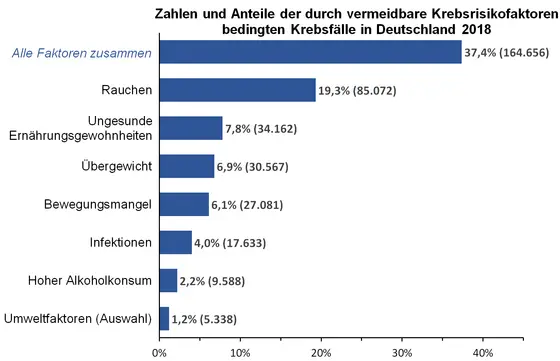A healthy lifestyle can help avoid the major cancer risk factors. However, how many cancer cases in Germany are in fact connected to specific lifestyle-associated risk factors? A team of scientists led by Ute Mons and Hermann Brenner from the German Cancer Research Center (DKFZ) in Heidelberg has now been the first to quantify this for the expected new cancer cases in Germany in 2018.
The scientists based their calculations on all 440,000 cancer cases among adults ages 35 to 84 and on those risk factors for which a causal link to cancer development is considered firmly established.
In a series of three articles in the current issue of “Deutsches Ärzteblatt“, the authors quantify the share of cigarette smoking, high alcohol intake, excess body weight, physical inactivity, poor diet, infections, and selected environmental factors (radon, particulate matter, indoor tanning, secondhand smoking) in causing the overall number of new cancer cases.
“These figures, which are now available for Germany for the first time, provide an important basis for prevention research,“ said DKFZ Chairman and Scientific Director Michael Baumann. He added: “We could avoid much more than a third of all new cancer cases if we fully exploited the potential of cancer prevention. This would not only save tens of thousands of lives but additionally spare substantially more people the fate of a severe disease and the distress it brings.“
Brenner and Mons think that the determined proportion of 37 percent of preventable cancers is still a low estimate. In many cancer types, the links to individual risk factors have not yet been proven and have therefore not been included in the risk calculation. Other risk factors such as natural UV radiation could not be considered because there are not enough data available. Therefore, the result could in fact be considerably higher. “If we additionally include the potential of early detection strategies such as screening colonoscopy, then the proportion of preventable cancer cases is much higher - an estimated 50 percent or more,“ Brenner adds.
In addition, many cancer risk factors also promote other chronic conditions, particularly cardiovascular diseases. Cancer prevention therefore is broad health prevention.
On the one hand, the age-adjusted cancer mortality rate has declined by almost 25 percent over the past two decades thanks to the introduction of individual effective prevention and screening examinations as well as major enhancements in the treatment of many cancer types. On the other hand, however, the absolute number of cancer deaths is still growing, because more and more people in Germany get cancer as life expectancy and the number of elderly people continue to rise.
“With these estimates, we want to provide guidance for public health policy makers and also doctors and other healthcare professionals that will help use the vast untapped potential of cancer prevention more efficiently,“ Brenner said.
In the present study, Brenner and Mons have used a calculation method that is very common in epidemiology. Scientists use it to calculate the number of cases by which the incidence of a disease could be reduced if the prevalence of a certain disease risk factor was eliminated or reduced in the population under study. For cancer risk factors, previous studies in Germany have always been based on results from the United Kingdom.
“As expected, the results for Germany and the United Kingdom are quite similar,“ Mons said. “However, we see a significant difference in the risk factor of tobacco smoking. Tobacco use accounts for 19 percent of all cancer cases in Germany, while it is responsible for only 15 percent in the UK. This shows that Germany is at the bottom of the league among European countries when it comes to implementing effective tobacco prevention strategies. In countries pursuing effective tobacco prevention measures, such as the United Kingdom or, for example, Australia, the cancer death toll from smoking has by now become much lower than it is in our country.“
Brenner also sees a need for political action regarding the risk factors of excess body weight and lack of physical activity, which both are epidemically spreading worldwide. “It is particularly alarming that these two risk factors have their origins already in early childhood. Here one should give the highest priority to preventive measures*. For example, health-promoting pricing strategies such as tiered VAT rates, may create important financial incentives for a healthy diet in the family. The school environment should urgently promote sufficient physical exercise.“
“It will take many years before the success of preventive measures will become visible. And powerful cancer prevention will not come for free,“ Baumann says. “But advances in cancer therapy cost an even higher price. In the long term, prevention will pay off, also in health economy.“
The study was financially supported by German Cancer Aid (Deutsche Krebshilfe, Funding number 70112097)
Ute Mons, Thomas Gredner, Gundula Behrens, Christian Stock, Hermann Brenner: Krebs durch Rauchen und hohen Alkoholkonsum - Schätzung der attributablen Krebslast in Deutschland
DOI: 10.3238/arztebl.2018.0571
Gundula Behrens, Thomas Gredner, Christian Stock, Michael F. Leitzmann, Hermann Brenner, Ute Mons: Krebs durch Übergewicht, geringe körperliche Aktivität und ungesunde Ernährung - Schätzung der attributablen Krebslast in Deutschland
10.3238/arztebl.2018.0578
Thomas Gredner, Gundula Behrens, Christian Stock, Hermann Brenner, Ute Mons: Krebs durch Infektionen und ausgewählte Umweltfaktoren - Schätzung der attributablen Krebslast in Deutschland
10.3238/arztebl.2018.0586
Deutsches Ärzteblatt, September 3, 2018
* These measures have been developed by Deutsche Allianz nichtübertragbarer Krankheiten (German Alliance on Non-Communicable Diseases): https://www.dank-allianz.de/files/content/dokumente/DANK-Grundsatzpapier_ES.pdf
A graphic is available for this message:
Attributable-Krebsfaelle-Alle-Faktoren.png
Note on use of images related to press releases
Use is free of charge. The German Cancer Research Center (Deutsches Krebsforschungszentrum, DKFZ) permits one-time use in the context of reporting about the topic covered in the press release.
Distribution of images to third parties is not permitted unless prior consent has been obtained from DKFZ's Press Office (phone: ++49-(0)6221 42 2854, E-mail: presse@dkfz.de). Any commercial use is prohibited.



